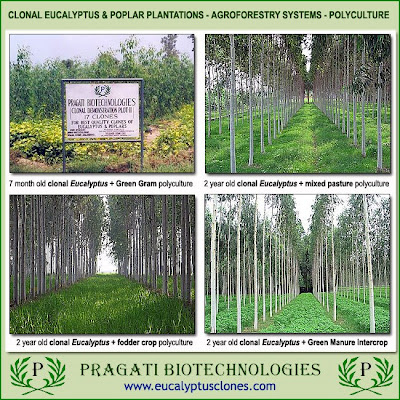Gustavo Iglesias Trabado 
GIT Forestry Consulting - Consultoría y Servicios de Ingeniería Agroforestal - www.git-forestry.com - EUCALYPTOLOGICS

GIT Forestry Consulting - Consultoría y Servicios de Ingeniería Agroforestal - www.git-forestry.com - EUCALYPTOLOGICS
A combined plantation of Eucalyptus and wheat? Combining Eucalyptus and pasture? Planting at once Eucalyptus and green manure crops? Noooo. Are you nuts? That's impossible. Everyone knows the "Environmentalist Theorem nº 835/a" states that Eucalyptus are those evil alien invasive tree species poisonous to your soil, and where you plant one, nothing can grow again.
Luckily for our hungry world, reality is almost always very different to environmentalist mythology.
Eucalyptus Polyculture in India: timber and grain
One out of many good examples of this are the eucalypt and poplar trees of Mr. Piare Lal in Andhra Pradesh and the Punjab. After nearly 40 years of experience in applied forestry science, the grounds of Pragati Biotechnologies (www.eucalyptusclones.com) are today a landmark for high-tech forestry, located not too far away from where the pioneers of the Green Revolution developed 'Kalyan', the first high yielding wheat of India.
But these versatile trees able to yield multiple products and services are not simply raised there for delivery to Indian farmers. Operational fields trials allow visitors to also see the combined outcomes of both tree breeding and intelligent agro-forestry design.
Eucalypt cultivated forests can achieve this way a new dimension: joining agricultural and forestry productions within the same pieces of land. Annual crops of yearly benefit while timber matures.
(Click image to enlarge)
Over 150 different select Eucalyptus clones, of both first generation pure and advanced generation E. tereticornis x camaldulensis hybrids, are being made available by Pragati Biotechnologies to tree investors in Punjab, Haryana & Uttar Pradesh wanting to take advantage of the genetic gains delivered by eucalypt tree domestication and breeding. Doubling or treebling the MAI achieved with standard tree nusery stock and making it compatible with other crops is no joke for a country with ever increasing needs of both food and raw timber. It is however a task for Norman Borlaug styled characters. Of Piare Lal type.
Corollary...
At Eucalyptologics we hope that, next time you hear or read one of the many misguided "environmental activist" trying to spread analphabetism on the subjects of monoculture, invasive alien species or Eucalyptus poisoning soils instead of trying helping fix the real problems out there, you remember cases as the one depicted today. You can then compare and decide for yourself what's going on with all that green mythology spreading like a noxious weed. Luckily, sooner or later, myths fall by their own weight. Or sometimes, with your extra help.
Also at EUCALYPTOLOGICS...
 Seven key issues on Eucalyptus and alelopathy
Seven key issues on Eucalyptus and alelopathyOr seven reasons why stating eucalypts poison soils is mostly... bullshit
Contact us / Subscribe to Eucalyptologics
© 2007-2008 Gustavo Iglesias Trabado. Please contact us if you want to use all or part of this text and photography elsewhere. We like to share, but we do not like rudeness.



































![Validate my Atom 1.0 feed [Valid Atom 1.0]](http://gus.iglesias.googlepages.com/valid-atom.png)






















2 Comments by our readers :::
Posted by François on 12/17/2008, 4:11 am, in reply to "Eucalyptus poisoning soil? (II) Growing trees & wheat in India"
This reminds me of something I heard about farmers in France who let grow trees in their fields, but not as intensively as on the example you show. Although at first it was thought that the trees would have a limitating effect on the annual yields of the crops it turned out that the annual yield increased compared to mono-culture.
I can think of several positive influences from the trees like increased organic materials % in the soil, wind breaking, ... . The only limitations I can think of are competition for water and shade from the trees.
The first one I have witnessed myself with young poplars and a flower bed under these (how silly of me to try to grow abbuals under poplars), the second one is easy to solve by pruning.
In grassland the water competition is not really a problem in Belgium, I have century old ashes & oaks growing at the side of pastures and I do not see any lesser growth of the grass near the trees compared to the open places. In dry & hot summers the grass even grows better in the shade of the trees (hasn't been an issue the lasttwo years ...).
This spring I intend to plant poplars (Populus trichocarpa) widely spaced in the pastures.
The bad reputation of Eucalyptus can originate from very dense plantations where indeed nothing might grow under the trees due to light deficiency.
But this is exactly the same as what happens when Picea trees (as an example) are planted at very close spacing for intensive forestry. The first 10 to 20 years there is almost no sunlight reaching the soil in such forests - a kind of perpetual night - until they start to clear the forest.
Posted by Gus on 12/17/2008, 3:55 pm, in reply to "Re: Eucalyptus poisoning soil? (II) Growing trees & wheat in India"
You make very good points François :-)
It is important to remember that "no recipe" of agriculture or agro-forestry is universal. Each area has its different soil, climate and water availability. These are what mostly define the productive potential and yield. You can "tweak" the first a bit (not always) with agricultural practice, take advantage of the second by matching the right species or combination of species to grow for an area, and you can sometimes "improve" the third (irrigated crops always more productive than non irrigated).
You well mention one of the theoretical benefits of these mixed systems: the whole (multiple crop) is more valuable (yields higher benefits overall) than its separate parts (any of the single crops cultivated individually).
And you well mention two main factors accounting for competition between both crops. Matching well crops whose overall water demand is not too high for normal water availability in the area, or compensating this with seasonal irrigation can help solve the first problem (water). Using understorey species or cultivars able to tolerate partial shade, and/or modifying tree stocking (thinning) or tree shape (pruning) along time can help solve the second problem (light).
What we wanted to show is that many things are possible with eucalypt (and many other) trees. And it is not a denial of alelopathy, just an extra perspective on it to see that a big majority of times, its practical negative effect approaches zero.
The bad reputation of eucalypts in this sense is the result of ignorant exaggeration of a fact into a generalised false truth. In many cases, what is really happening in a high stocking tree stand has little or nothing to do with alelopathy (exactly as in the good example you gave with Picea trees). Hence, I think we are well entitled to call those using that negative topic in their speech beyond the strict objective boundaries of science as "ignorant myth propagators". As such we should learn to identify them by their speech or writing on the subject.
Thanks for the input, and good luck with those poplars! :-)
Send a comment to EUCALYPTOLOGICS